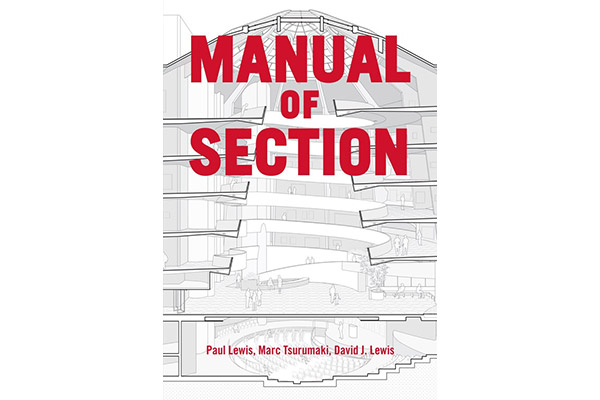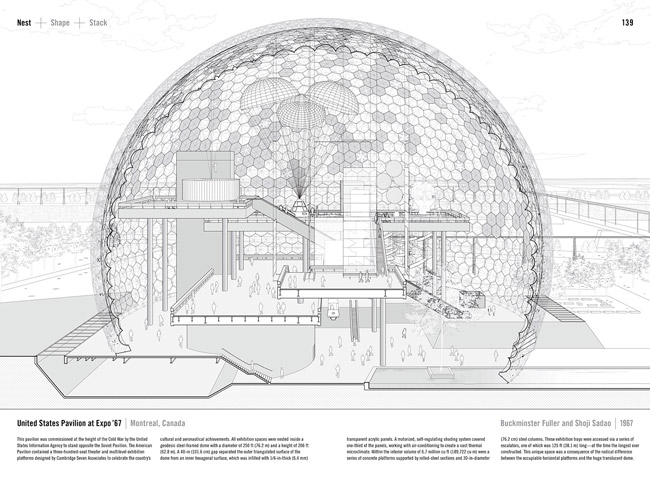by: ac
On 01.09.17, the Center for Architecture hosted its first Oculus Book Talk of the year, featuring Paul Lewis, AIA; Marc Tsurumaki, AIA; and David J. Lewis, AIA, principals at LTL Architects, in a tag-team lecture on their new book, Manual of Section. Working in the realm of visual scholarship, this book demystifies the most abstract of architectural drawings—the section—by discussing it both technically and historically. The LTL trio walked the audience through most of the text’s finer points and emphasized the poetic history of section drawings.
The book is wonderfully instructional; as an educator, my impulse is to tuck it under arm and take it to my next class. Traditionally the section, one of the most difficult drawings to teach, has been used as a documentation tool to fuel construction information; Manual of Section presents the section as a design tool. The text’s major intent is to illustrate how a building’s design can be organized and conceptually conceived via section.
Over 60 section drawings of exemplary buildings, generated by LTL’s studio, comprise the body of the tome and adhere to a somewhat vague series of architectural gestures that LTL uses to assess the structures. The gestures—incline, hole, nest, stack, and shape—are meant to explain the formal intent of the section, but are most useful when examining a real estate-driven building section versus a conceptually-driven section. Unfortunately, the taxonomy is never as interesting as the individual drawings, which are endlessly fascinating. Drawn on Rhino, LTL’ s 21st-century sections are systematically cut, then extruded into a one-point perspective, allowing the viewer to examine the spatial quality of the structure.
The book also introduces the readers to some under appreciated buildings: Charles Moore’s Orinda House is a fine investigation into the interior formalism of the architect’s work. The simple Lake Arrow Head House actually shows Rudolph Schindler’s interest in roof assembly, making the space deep and thoughtful. And Henri Sauvages’ quietly impressive Rue de Amiraux building aptly makes the point that a section can manifest a deep understanding of an urban condition.
Central to the book is the powerful history of the drawing type. From Leonardo da Vinci’s voluptuous section of a human skull to the brooding Boullé drawings, all cited examples point to the atmospheric potential of the section drawing. This history illustrates that the intent of any section drawing is to explain a building’s relationship to the ground and its tectonic composition. The authors’ brief presentation of a series of Violette le Duc’s sectional explorations to examine stone versus assembled buttresses is a classroom lecture in itself.
The historic examples cited and illustrated in the book do offer up a criticism of the section drawings created by LTL. All the historical drawings illustrate shade, shadow, and materiality; sadly, many of the drawings in LTL’s taxonomy offer a more clinical view of space, presenting less of an immersive experience. Materiality is drawn but not always examined in the drawings, making the wall section thin and unexpressive. The rigor that the LTL drawings put forth illuminates where information is missing; often times the floor slabs are illustrated as open 18” to 32” slabs where maybe a supposition of the HVAC systems of the building could have been shown. It seems odd that, while the authors proclaim the section drawing as a friend to environmentally efficient buildings, no such information appears in the case study drawings.
Nonetheless, this text is a necessary and potent exploration of architectural space and an impressive body of knowledge that is sure to influence generations of designers to come.
Event: Oculus Book Talk: Manual of Section
Location: Center for Architecture, 01.09.17
Speakers: Paul Lewis, AIA, Marc Tsurumaki, AIA, and David J. Lewis, AIA, Principals, LTL Architects
Organized by: AIANY Oculus Committee









